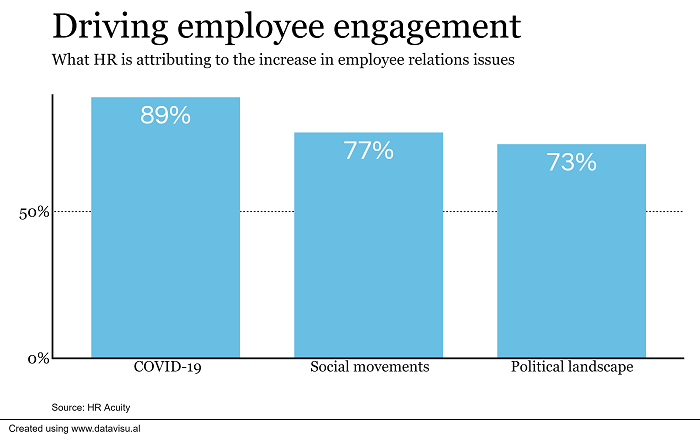Ensuring that its 75,000 employees are engaged in their work has always been at the core of Salesforce’s strategy.
But the pandemic turned everything about employee engagement on its head.
“The assumptions of the past are no longer valid in the present,” Ernest Ng, vice president of global employee success strategy and people analytics at Salesforce, said Wednesday at HRE’s HR Tech Virtual Conference. (The free online event runs through Friday; register here.) “What we’re seeing in our research is that the conditions that drove engagement in the past are really different now.”
A number of things have changed in a COVID-19 world: Work/life integration is now to the extreme; most employees are overworked and overburdened; networks have shrunk; and interactions are transactional, Ng said. “It all really starts to change the way that we engage with each other.”
Employee engagement is a widespread challenge on the heels of the pandemic. According to 2021 Gallup data, just 20% of workers are engaged in their work.
 The key to employee engagement, Ng said, is balancing “both the head and the heart”—and relying on tech and data to help connect workers and make their lives easier. “Our formula for driving employee engagement is culture plus technology plus data equals engagement,” he said.
The key to employee engagement, Ng said, is balancing “both the head and the heart”—and relying on tech and data to help connect workers and make their lives easier. “Our formula for driving employee engagement is culture plus technology plus data equals engagement,” he said.
Employers need to have core values that are instilled in everything they do, as well as trusted relationships with their employees, he said. “You want people to trust your organization that you know what you’re doing, because that’s the foundation that you can build upon to drive that engagement,” he said.
Related: Want to create a high-performance culture? Be intentional
“We are a values-driven organization, and underlying everything that we do are our core values of trust, customer success, innovation, quality and sustainability. Those are the things that ground everything that we do.”
Technology helps manifest that culture into reality, he said, by helping to ensure workers are connected.
 For instance, the company puts all of its new hires in a “yearlong marketing cloud journey,” explained Jenn Galbraith, vice president of employee success digital transformation at Salesforce, where employees are sent content that offers answers to frequently asked questions, helps them with common onboarding tasks and more.
For instance, the company puts all of its new hires in a “yearlong marketing cloud journey,” explained Jenn Galbraith, vice president of employee success digital transformation at Salesforce, where employees are sent content that offers answers to frequently asked questions, helps them with common onboarding tasks and more.
New workers also are assigned a “work buddy”—a person new employees can go to to ask questions and to get tips and tricks on how to navigate the organization.
Salesforce also has a tool on the Salesforce platform called Concierge that provides answers to commonly asked questions about employee benefits, workforce technology and more. It also offers a plethora of articles, tips and resources.
Other digital platforms help collect feedback from workers, connect them with other employees, and share and obtain career goals.
 The key, Galbraith said, is to have a balance of technology and human touches that ensure employees know the company cares. “It’s a game where were we very intentionally chose to automate certain things, but not automate those things that are really going to build that connection.”
The key, Galbraith said, is to have a balance of technology and human touches that ensure employees know the company cares. “It’s a game where were we very intentionally chose to automate certain things, but not automate those things that are really going to build that connection.”
One of the main reasons for using tech in the workplace is to “free up time for us to focus on the human touch and the human connection and the building of those relationships,” she said.



